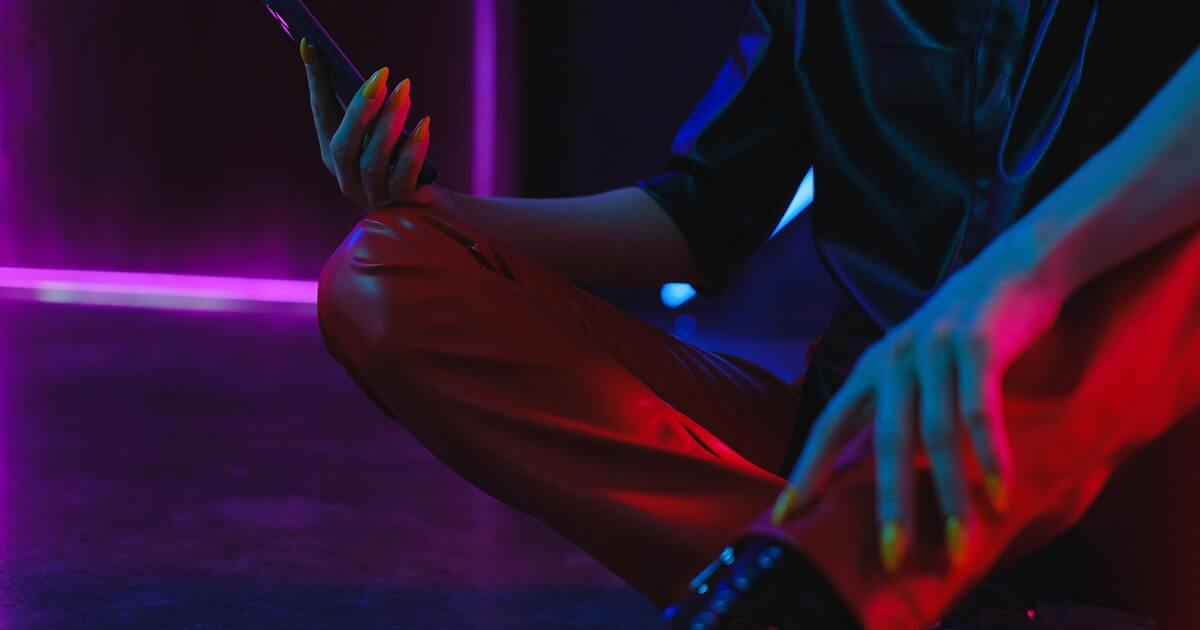Tighter. Please. Keep my mind still. Help my mind stay in this body. I pray to anyone who will listen. Winding, twisting, knotting, allowing myself to be tied into place. Tying the knots so tight my mind will not stray away from me. Wrapped in red cottons, black hemp and Costco rope. All in attempts to wrangle my mind to calm. So that I am present for my own worship. A safe, consensual, kink that encourages risks, evokes healing, and for me, demands presence.
With my diagnosis of Bipolar II Disorder, there are definitely times I feel my brain doesn’t belong to me. I find that choosing to take medication, attending culturally relevant forms of healing, therapy, getting outta bed in the morning, eating, showering, (the list goes on and on), are all conscious efforts I make each day – many of which folks take for granted. So for this queer, intelligent, witty, neurodivergent, Brown cutie, feeling “better” is so hard to do that at this point, I’ll try anything that I haven’t already.
Do I sound fed up to you? Because I am. I constantly feel like I’m convincing my mind to stay with me and be kind. Trying to remember what it’s like to feel beautiful through the haze that is often my mind requires so much patience with myself. So when I allow myself into submission, I’m letting go completely of the vain desires to be in control. I’m clearing away the static sounds of chaos inside my head, an image I liken to tons of sand falling inside my head, causing so much discomfort in my skin, making me feel like my purest thoughts of joy, bliss, roaring laughter, rivers of healing tears and orgasms are being suffocated away.
Submission? Grrrl, my ancestors have not survived 500 years of occupation for me to be submissive, says my mind and its valid suspicion of all things white-dominated. Now when you think of BDSM (or Bondage, Discipline, domination, submission, Sadism, Masochism), what do you picture? A thin white able-bodied woman band-aiding problematic behavior with queerness? A white twink with the privilege to seek out what they deem, “the exotic?” Well grrrl lemme tell you, that archetype of BDSM is completely basic.
Shibari, according to Kinkly, is a traditional form of artistic rope bondage that originated in Japan.Thin pieces of rope are used to create intricate geometric patterns and shapes … more recently, the term Shibari has become a common term throughout the world to describe the intricate rope bondage practiced in BDSM play. Shibari is often considered a power exchange between people through the use of rope. Folks who participate in Shibari may use different textured ropes, chains, etc. as a means to stimulate the feel against the skin in different ways. Knots and ties can be placed along pressure points, almost like a Shiatsu massage.
Of course, there are so many different ways that kink, BDSM, rope play, and Shibari can manifest, especially for folks with disabilities, and I don’t aim to represent it all. For some folks it may mean using added tools or resources, such as using a pillow to prop the subs, (the homie being tied up), so that they feel as relaxed and as comfortable as possible. Or incorporating folks’ wheelchairs into the scene, if they wish, really the aim is creating a safe and trusting environment for everyone to participate. Or consistent check-ins with folks who live with asthma, anxiety, and panic attacks, or other disabilities. To add, Shibari is also about the person that ties the rope (the Dom), be sure that they have access water as needed, is communicative with the sub and checking in. Any way that you frame it, however, most people do not consider that folks with disabilities can even participate in BDSM, not to mention disabled folks of Color.
So for me, applying Shibari to my methods of healing is a way to reclaim relationship with my body and mind. Learning to trust the decisions I’ve made, to feel still and safe, but not stuck, practicing my breathing in attempts to be more conscious and grateful for my autonomic nervous system. As a disabled queer person of color, with Native and Caribbean descent, reclamation of my body, my mind and sexuality is an act of revolution. Living daily with symptoms of Bipolar II Disorder is extremely difficult at times, often making me feel like I must be as social and productive as possible whilst I feel well today, otherwise tomorrow can escape me, depending on flare ups. For different folks, symptoms of Bipolar Disorder II vary. I experience mania or hypomania, which can mean that my decisions can’t be trusted. When I’m feeling all over the spectrum emotionally, my racing and exhausted mind is called back to my body when subbing during the art of Shibari. Being attended to by my Dom, not having to worry about my next move, (or next five, if i’m being honest), I am encouraged to not feeling guilty about my desires, my impulsiveness or my actions. Healing through Shibari not only allows for me to decide what coping with hypomania looks like, it also allows for me to break the exclusive and racist undertones of the BDSM scene.
Reclaiming the understanding that healing takes time and undoing generations of trauma also means remembering that I carry 7 generations of beauty and resilience. So when I feel ropes and knots around my body, as loose or tight as I want them, this means I can define the emotions I want to come up in that scene. I’m able to feel my Brown skin, feel a taste of what it might mean to feel safe. I’m able to feel okay in this sober body that is sober as a means to appeal to my Bipolar Disorder and not by choice. Hoping that it all means that my mind will take mercy on me.
As a queer, disabled Person of Color, I have uplifted myself through self-titling, and as a self proclaimed, “Sadboi”, (a name given to myself, as I rebirthed myself as a healer of my own traumas and symptoms), I am able to love myself in ways that I have been taught not to. I am permitting myself to be kind to myself, kissing myself through ropes and knots tied in what feels like hugs. A practice that is defined by my needs, allowing my arms and legs bound as a means to become aware of my breathing, where my energy is being spent and exhausted, thusly becoming aware of my intentions. Attempting to be present, so that I may enjoy the feeling of beautifully colored ropes caressing my body, feeling the sensuality of my existence, being reminded that my worth is so much more than what my disorder tells me. Remembering that my pain and sorrow does not overpower my resilience and strength. Constantly humbling my disability to my existence.
About
Hablo Rodriguez-Williams
Hablo Rodriguez is a Two Spirit, first generation Colombian artist healer and writer. Their work centers the resilience of QTBIPOC and centers the magic that are disabled people of Color. Their writing reflects the perpetual naivety of having been on their own since they were 16 years old and exemplifies the wisdom of artists of Color. Click here to find their writing. Ometeotl Tlazocamati.
About Rooted In Rights
Rooted in Rights exists to amplify the perspectives of the disability community. Blog posts and storyteller videos that we publish and content we re-share on social media do not necessarily reflect the opinions or values of Rooted in Rights nor indicate an endorsement of a program or service by Rooted in Rights. We respect and aim to reflect the diversity of opinions and experiences of the disability community. Rooted in Rights seeks to highlight discussions, not direct them. Learn more about Rooted In Rights
Click here to pitch a blog post to Rooted in Rights.



